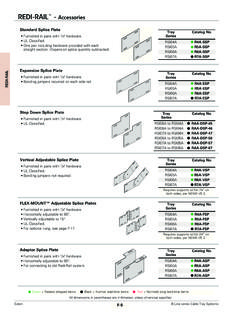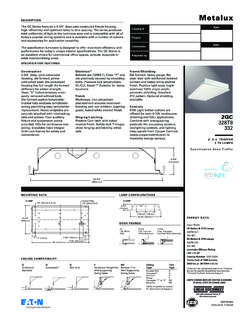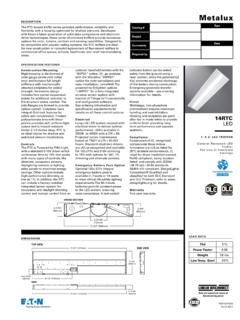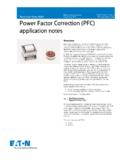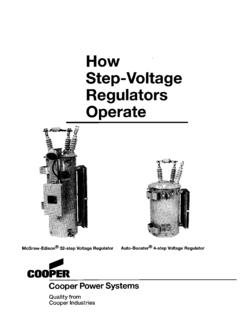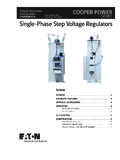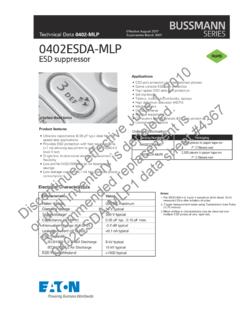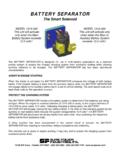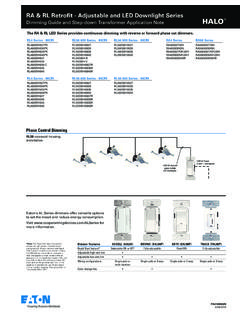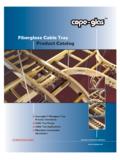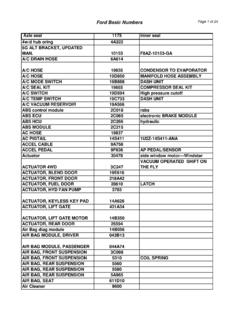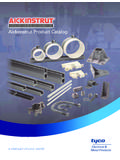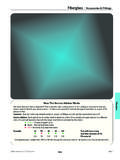Transcription of Selecting the right materials for cable tray use at high ...
1 Selecting the right materials for cable tray use at high temperaturesFrom the blistering heat of the Mojave Desert to the sweltering temperatures of foundries, cables need to be supported to ensure reliable power and communications. Locating cable tray over a boiler or in close proximity to a large furnace can produce some rather high temperatures. A good understanding of how materials perform at extreme temperatures is critical to avoid serious injuries and expensive general guidelines on the proper material to specify when dealing with high temperatures are listed tray MaterialMaximum Continous Recommended TemperatureStainless Steel800 FLow-Carbon Steel400-500 FAluminum180-200 FFiberglass90-120 FAluminum, fiberglass, steel, and stainless steel are all readily available materials for cable tray manufacturing.
2 These materials perform very well at ambient temperatures (0 F to 100 F). However, once the confines of these temperatures have been exceeded, the materials start to react differently. As temperatures rise, a materials tensile strength decreases. In other words, metals become weaker, less stiff, and more ductile. As far as reliability, the cable tray materials are listed below in order of least effective to most Polyester and Vinyl Ester cable trays are non-metallic, or in a very simple sense, plastic. Fiberglass trays are the least effective at dealing with heat.
3 Fiberglass cable tray loses 10% of its rated strength at temperatures as low as 100 F. At 200 F, fiberglass will lose up to 50% of its rated load. Use of additional supports is necessary to offset the decrease in material strength at temperatures above 100 highest continuous temperature rating for 600V building wire is 90 C (194 F). Specialty cable such as Teflon insulated nickel-coated wire can be rated up to 500 F. The limitations of the cables being supported are also very Aluminum exhibits better performance than fiberglass under elevated temperatures.
4 Based on the tensile strength of 6063-T6 aluminum alloy, aluminum loses only 9% of its strength at 200 F, while more than a third of its strength is lost by the time the temperature reaches 300 leadershipWhite paperEaton is a registered other trademarks are property of their respective Eaton BoulevardCleveland, OH 44122 United 2016 EatonAll Rights ReservedPrinted in USAP ublication No. WP302007 ENSeptember 2016 - BLTPS-01 Death Valley in the Mojave Desert holds the official record for the hottest place on Earth at 134 F.
5 Aluminum cable tray can readily handle this type of Low-carbon steel easily outperforms both fiberglass and aluminum in extremely hot environments. Standard steel tray will perform quite well with very little change in strength for temperatures up to 600 F. At 800 F, low-carbon steel loses about 10% of its strength. By the time the temperature reaches 1000 F low-carbon steel drops to 50% of its strength at room temperature. Remember to also consider the limitations of the protective coating applied to your steel tray . A coating such as paint could discolor or deteriorate at temperatures well below the service temperature of the steel melts at 788 F; therefore a zinc-coated steel cable tray might experience serious corrosion problems at these extreme Steel Stainless steel is the most effective material for dealing with high temperatures.
6 At 800 F, AISI type 304 and 316 stainless steels lose approximately 14% of their room temperature strength, however their room temperature strength is initially 15% greater than that of low-carbon steel. Consequently, stainless steel exhibits greater strength at 800 F than low-carbon steel displays at room temperature. At 1200 F, type 316 stainless steel has lost only a third of its strength at room temperature. Type 316 outperforms 304 stainless by approximately 15% at these extremely elevated stainless steels outperform other cable tray materials at elevated temperatures, there is the possibility of a phenomenon called intergranular corrosion with long-term exposure to temperatures above 800 F.
7 This corrosion causes a deterioration of the material that could decrease the life expectancy of the material anywhere from 15-50% depending on the temperature and other environmental factors. One solution is to specify a low-carbon stainless steel such as type 304L or 316L. The lower carbon content in these stainless steels will help prevent intergranular corrosion from are many considerations in choosing the correct cable tray material for use in high temperatures. With a careful analysis of your environment and the materials available, you are sure to find a cable tray system to meet almost any us on social media to get the latest product and support information.
